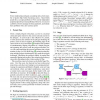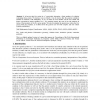CORR
2010
Springer
14 years 7 months ago
2010
Springer
We present capacity results of the binary-symmetric parallel-relay network, where there is one source, one destination, and K relays in parallel. We show that forwarding relays, wh...
AUTOMATICA
2004
14 years 7 months ago
2004
In any real-life identification problem, only a finite number of data points is available. On the other hand, almost all results in stochastic identification pertain to asymptotic...
TSP
2008
14 years 7 months ago
2008
Abstract--Digital processing techniques are based on representing a continuous-time signal by a discrete set of samples. This paper treats the problem of reconstructing a periodic ...
SIAMAM
2008
14 years 7 months ago
2008
Wave scattering by an array of bodies that is periodic except for a finite number of missing or irregular elements is considered. The field is decomposed into contributions from a...
CORR
2008
Springer
14 years 7 months ago
2008
Springer
As an example of the recently introduced concept of rate of innovation, signals that are linear combinations of a finite number of Diracs per unit time can be acquired by linear fi...
CORR
2010
Springer
14 years 7 months ago
2010
Springer
We present an algorithm running in time O(n log n) which decides if a wreathclosed permutation class Av(B) given by its finite basis B contains a finite number of simple permutati...
CCCG
2006
14 years 8 months ago
2006
Every simple planar polygon can undergo only a finite number of pocket flips before becoming convex. Since Erdos posed this as an open problem in 1935, several independent purport...
DEXA
2008
Springer
2008
Springer
Evolutionary Clustering in Description Logics: Controlling Concept Formation and Drift in Ontologies
14 years 9 months ago
Abstract. We present a method based on clustering techniques to detect concept drift or novelty in a knowledge base expressed in Description Logics. The method exploits an effectiv...
ADG
2006
Springer
15 years 1 months ago
2006
Springer
It is known that five points in 3 generically determine a finite number of cylinders containing those points. We discuss ways in which it can be shown that the generic (complex) nu...
ICCV
2005
IEEE
15 years 9 months ago
2005
IEEE
In this paper we develop a theory of non-parametric self-calibration. Recently, schemes have been devised for non-parametric laboratory calibration, but not for selfcalibration. W...





